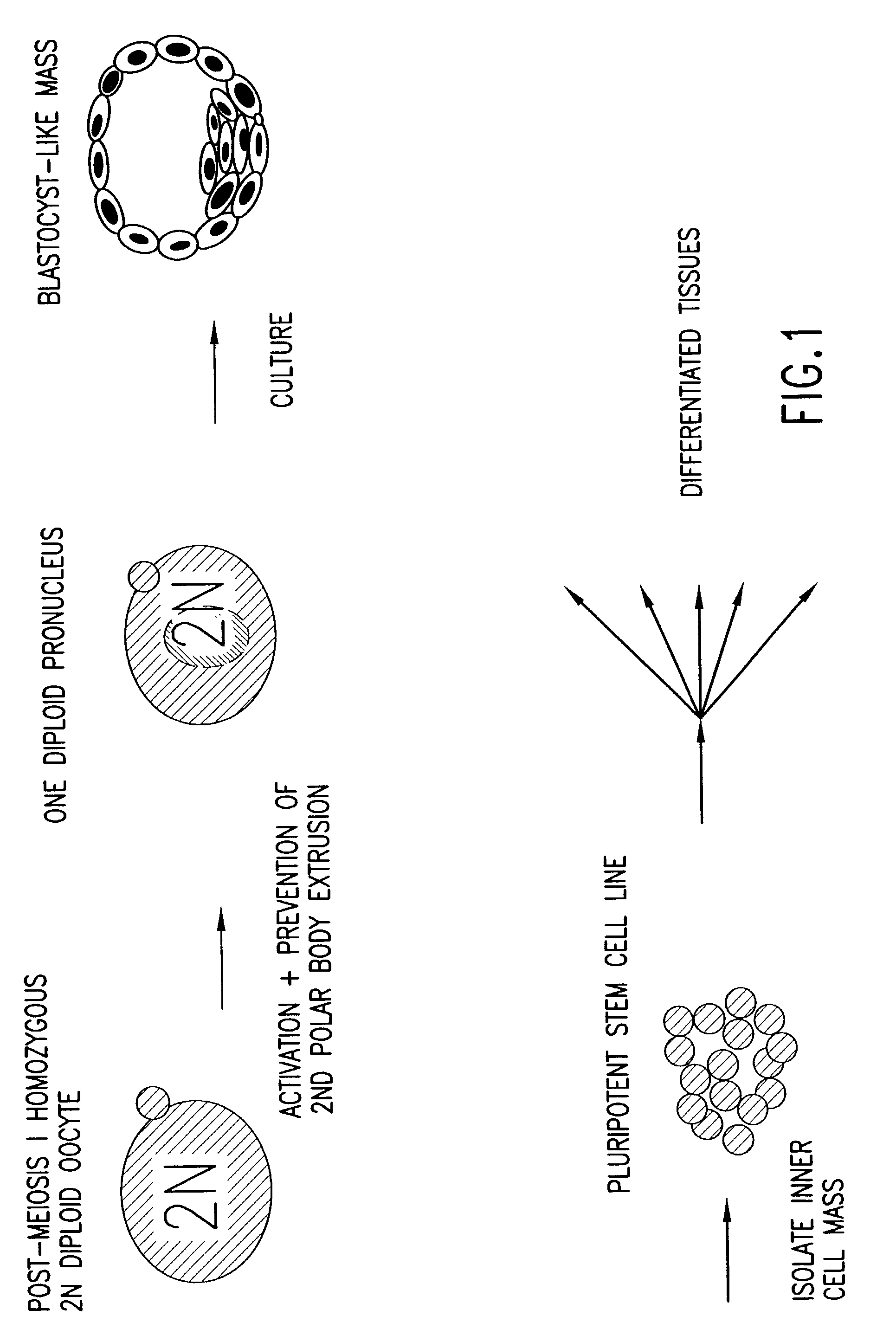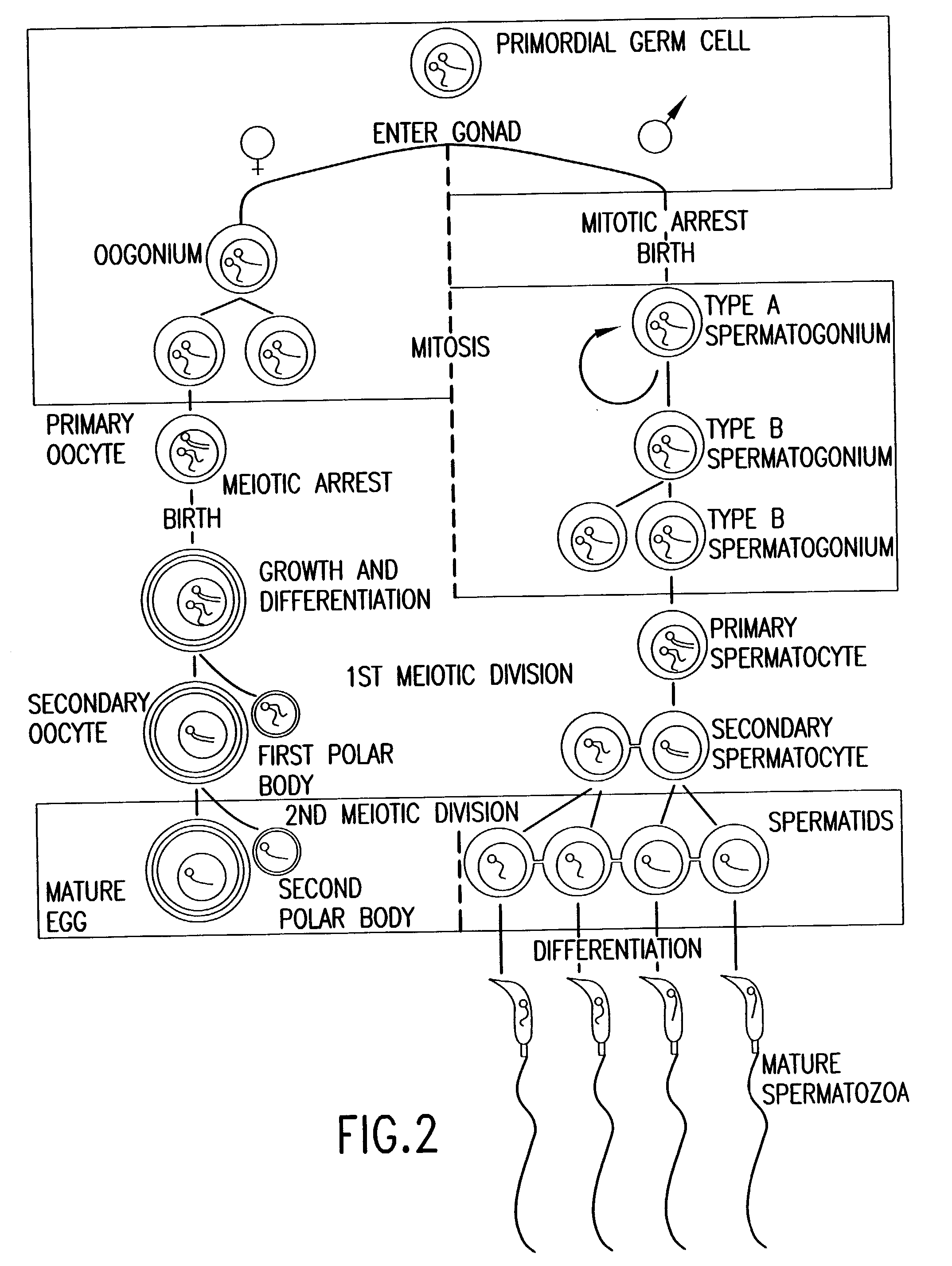Isolated homozygous stem cells, differentiated cells derived therefrom, and materials and methods for making and using same
a technology of homozygous stem cells and differentiated cells, applied in the field of pluripotent homozygous stem cells, and methods and materials for making same, can solve the problems of unsatisfactory therapeutic use of somatic nuclear transfer lines, failure to create stem cells from non-fertilized embryos, and inability to meet the needs of es cell use and development,
- Summary
- Abstract
- Description
- Claims
- Application Information
AI Technical Summary
Benefits of technology
Problems solved by technology
Method used
Image
Examples
example 1
Homozygous Stem Cell Formation, and Their Differentiation into Progenitor Cells and Various Tissues of the Three Embryonic Germ Layers within Teratomas
Example 1(a)
Derivation of HS Cells from Mouse Post-Meiosis I Oocytes by Activation Followed by Prevention of the Extrusion of the Secondary Polar Body
[0268] 73 Oocytes were obtained from hybrid (BDA2 F1: C57 black.times.DBA2, Charles River Laboratories, Wilmington, Mass.), eight-week old, female mice by superovulation using the following procedure. Three hybrid mice were administered injections of 5 IU / 100 ul of pregnant mare's serum gonadotropin (PMS; PCCA, Houston, Tex. (29-10001BX)), and 5 IU / 100 .mu.l of human chorionic gonadotropin (HCG; Sigma, St. Louis, Mo., (C8554)) about 48 hours apart.
[0269] Oocytes were harvested about 17 hours after the HCG injection, and the cumulus mass was removed by incubating the freshly obtained oocytes in a drop (.about.300 .mu.l) of hyaluronidase (H4272, Sigma) dissolved in M2 media (M7167, Sigma) ...
example 1 (
Example 1(g)
Development and Isolation of Homozygous Progenitor Cells from Transplanted HS Cells
[0306] To obtain homozygous progenitor cells, pluripotent HS cells derived from methods disclosed in the foregoing in the foregoing description and examples are transplanted into immuno-compromised mice under kidney capsules and are allowed to grow in vivo for 4 to 6 weeks. The cell mass obtained is then minced into single cells and cultured on feeder cells for further propagation and development into cell lines To assess the lineage commitment (the types of progenitor cells ), gene expression assays, such as RT-PCR, northern blot, immunohistochemistry, and so forth, are performed for known lineage-specific markers, for example, NF-H, keratin, D-beta-H for the ectoderm, enolase, CMP, rennin, kallikerein, WT1, delta-globin, beta-globin for the mesoderm, and albumin, alpha-1-AT, amylase, PDX-1, insulin, alpha-FP for the endoderm progenitor lineages.
example 2
Differentiation of Mouse HS Cells into Cells from the Mesodermal Embryonic Layer
Example 2(a)
Differentiation into Hematopoietic Cells
[0307] Mouse HS cells were cultured in ES medium (DMEM Gibco 1195-065; FBS Gibco 16141-079, 100 .mu.M Non-Essential amino acid Gibco 11140-050; 50 units / ml Penicillin-Streptomycin Gibco 15070-063; 100 .mu.M .beta.-Mercaptoethanol Gibco 21985-023) with LIF (1000 IU / ml) for 3-5 days. The cells were then trypsinized with Trypsin / EDTA (Gibco 25300-054, 1 ml / 60 mm dish) for 5 minutes at 37.degree. C. and 5 ml of ES medium was added. The mouse stem cells were lifted from the dish by cell scraper and the cell suspension was spun at 1000 rpm for 5 minutes. The cell pellet obtained was resuspended in ES medium without LIF and with 4.5.times.10.sup.-4 M MTG (monothioglyceral Sigma M6145) at the cell concentration of 2.times.10.sup.6 / 10 cm dish for 4 days at 37.degree. C. and 5% CO.sub.2. Mouse HS cells were then aggregating in suspension to form embryoid bodies (...
PUM
| Property | Measurement | Unit |
|---|---|---|
| pH | aaaaa | aaaaa |
| concentration | aaaaa | aaaaa |
| resting membrane potential | aaaaa | aaaaa |
Abstract
Description
Claims
Application Information
 Login to View More
Login to View More - R&D
- Intellectual Property
- Life Sciences
- Materials
- Tech Scout
- Unparalleled Data Quality
- Higher Quality Content
- 60% Fewer Hallucinations
Browse by: Latest US Patents, China's latest patents, Technical Efficacy Thesaurus, Application Domain, Technology Topic, Popular Technical Reports.
© 2025 PatSnap. All rights reserved.Legal|Privacy policy|Modern Slavery Act Transparency Statement|Sitemap|About US| Contact US: help@patsnap.com



